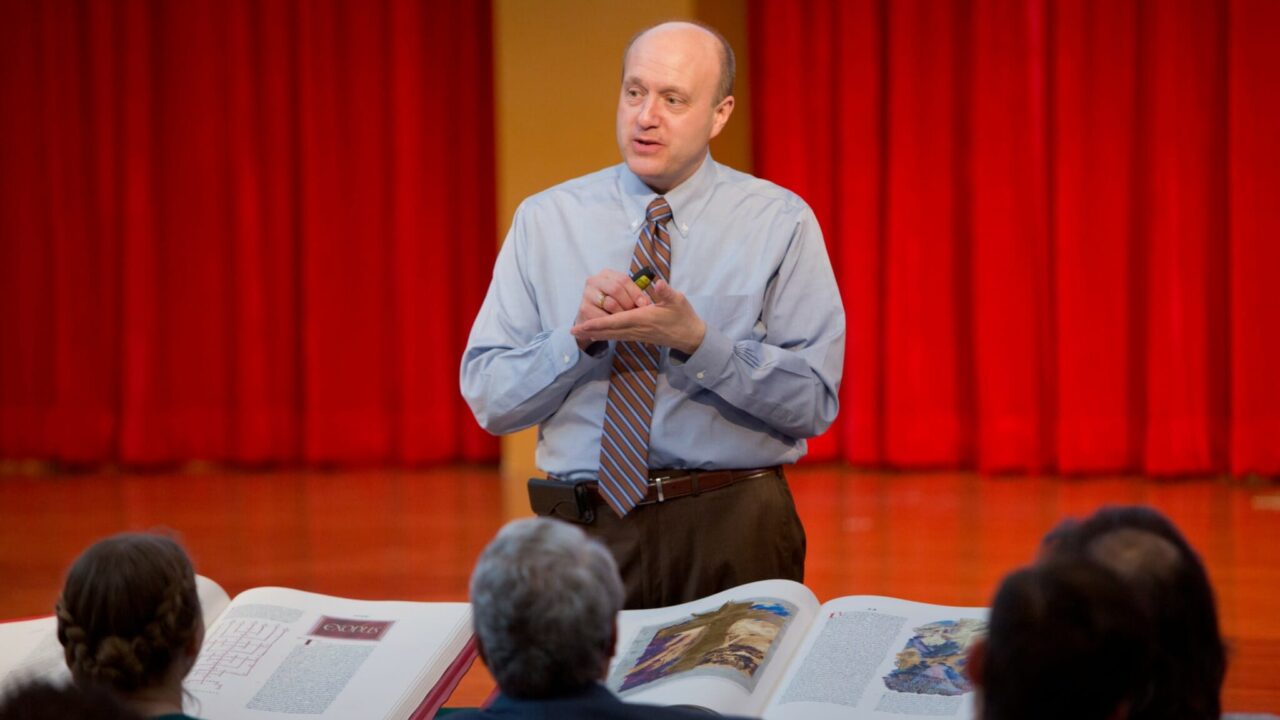Collegeville, Minnesota – 10 years. 20 years. 100 years. 500 years from now, the original manuscript of The Saint John’s Bible will most likely be bound in leather, to outlast the wearing of time. Imbued with care, the work was delicately crafted, written on calfskin vellum using traditional tools and ink to ensure the quality and longevity of its beauty and form. As the first hand-written, hand-illuminated Bible commissioned by a Benedictine monastery in the past 500 years, The Saint John’s Bible stands as this generation’s representation of the ecumenical Word of God. It truly sustains a legacy that is built to last.
However, the art of preservation transcends the protecting of the physical form of the Bible. It takes a dedicated and passionate individual to not only handle this artifact with exacting delicacy and wisdom, but to also open up for others the possibility to explore their spiritual imagination through engagement with the work.
For The Saint John’s Bible, this individual is Tim Ternes, Director of The Saint John’s Bible at the Hill Museum & Manuscript Library at Saint John’s University in Collegeville, Minnesota.

Sharing his knowledge and teaching others has always been a passion for Ternes. Prior to working with The Saint John’s Bible, Ternes worked as an elementary classroom teacher for sixteen years and as an independent language arts consultant to school districts around the country and internationally.
Ternes has acted as a key collaborator for the project, which was commissioned in 1998, since 2004. As Director, Tim worked closely with the artistic team in the creation of the original Bible folios. He also facilitated planning and communication between artists and commissioners.
Referred to as “the keeper of the pages and the keeper of the story,” Ternes works directly with the original manuscript, being one of the only a very few people to handle the pages on a regular basis. In addition to this, he manages international touring exhibition programs and on-campus gallery programs for the Bible and the museum’s rare book and art collections.
“Over the last 20 years, I’ve had the privilege of experiencing the powerful idea of the communal word coming to life. When people gather around the Bible, it’s hard not to fall in love with the illuminations. But what those illuminations are really designed to do is to not be didactic. They do not tell the story for you. The most exciting thing that I witness is when the people see the pages and I ask them ‘What do you see? What does this remind you of?’ From there, we have these powerful conversations that are about scripture passages, inviting the people to come together and make meaning collectively. It’s a great gift,” said Ternes.
The Art of Preservation
There is something uniquely magical about the original manuscript of The Saint John’s Bible. The sheer talent and work of all the scribes and artists are fortified on its unbound pages, carefully detailed on calfskin vellum using only traditional tools and precious inks to help bring the scripture to life.
The Saint John’s Bible Heritage Editions were created in order to offer an accessible experience for partners, communities, and individuals across the world to connect with this sacred piece of art. While the 299 seven-volume reproductions are true to the scale, beauty, and artistic intent of the original manuscript, the magic and sheer authenticity of the original work is carefully reserved under strict museum conservation codes at the Hill Museum and Manuscript Library. This way, the lifespan of the original text has the potential to outlast future generations to come.
Nevertheless, the original manuscript does not live alone, and select pages are always on display in the Library for visitors to experience in all its glory.

The Hill Museum holds the world’s largest collection of resources for the study of manuscript cultures, having photographed more than 140,000 complete manuscripts from 540 partner libraries worldwide, totaling more than 50,000,000 handwritten pages. The Library contains more than 15,000 rare books and manuscripts – including the 17th century Torah and fragments of the Qur’an – that are all under the same strict conservation codes, ethics, and care as The Saint John’s Bible.
“Each page of The Saint John’s Bible has a 5,000 light-hour footprint that it’s allowed over a five-year period. What exactly does that mean? For example, the Creation page can be exposed to five foot-candles of light for 5,000 hours during that five year period. When it reaches 5,000 hours, it has to go to bed for another five years and isn’t shown publicly until it’s fully rested. The same careful process is done for the humidity and temperature of the pages.
“I hope someone takes as good a care of me someday as we take care of the pages of The Saint John’s Bible,” said Ternes.
In addition to being the primary caretaker of the original manuscript, Ternes runs on-campus gallery programs for The Saint John’s Bible as well as the museum’s rare book and art collections. He also manages international touring exhibition programs, traveling around the world to facilitate over 8,000 presentations with the Bible (although, he stopped keeping count five years ago).

“The weight of The Saint John’s Bible is, every time you open that book, every time you go out into public, you are representing the collective and communal thoughts, thinking and energy of an entire community,” said Ternes. “The Saint John’s Bible is an extension of Saint John’s Abbey and University, but it’s also an extension of 23 living artists that worked on this project. I carry that responsibility of being the vehicle by which the work is delivered to greater audiences of people. I am the one extending the invitation, and so I must be invitational. The most beautiful thing about the work that I do is that I have spent my whole career saying, ‘Welcome and come on in. No matter who you are or what you bring to the table, come on in.’”
When Old Becomes New Becomes Newer
For centuries, libraries have been revered as a place of storage and knowledge. However, in recent years, the world has adapted into a digital landscape that completely shifted the process and limitation of research. People have access to more information than ever before – so what could this mean for the future of sacred texts and manuscripts?
When we ponder the legacy of The Saint John’s Bible in this regard, it’s important to remember that even 25 years ago, the completion of a project such as this was nearly inconceivable, and it remains that way today. The idea of a newly crafted, hand-written and illuminated Bible to emerge after 500 years was unexpected, especially during an age where you can find a copy of the Bible in the drawer of any hotel room.
“We’re very close to launching an online version that’ll let you electronically turn every page of the Bible and see it in great detail. But at its very heart, nothing’s going to change. We people are still communal, and we crave to be together. The gift of The Saint John’s Bible is its ability to bring people together and engage them,” said Ternes. “Everything else can change, but the communal nature needs to be preserved.”
Ten or 20 years from now, another curator will have stepped into the position of Director, continuing the work of predecessors before in preserving the original manuscript. However, the original pages will always remember the hands of Tim Ternes, the individual who passed on his extensive care and knowledge to others in order to preserve and keep this generation’s Word of God alive.
“The legacy of The Saint John’s Bible is that it’ll be rediscovered time and time again, over the next millennia, by all sorts of people. Scripture and faith as a whole are an invitation, whether you choose to accept it or not is up to you. The invitation is there, and the real beauty of The Saint John’s Bible is that there aren’t any strings attached to the invitation. It offers a moment of discovery for anyone who embraces it,” said Ternes.
The Saint John’s Bible Heritage Program
To read more stories similar to this one, subscribe to the Heritage Program’s monthly e-newsletter, Sharing the Word, or visit the blog.

